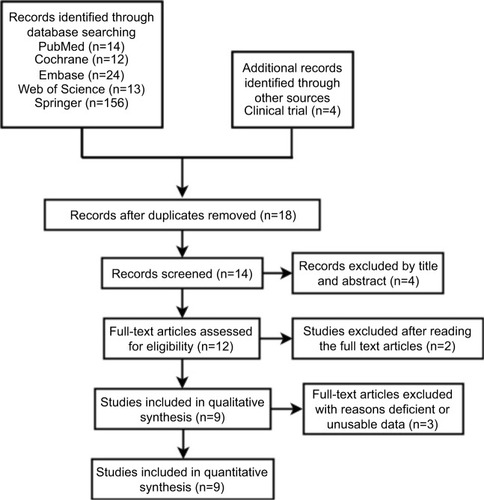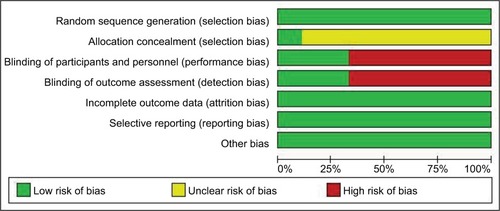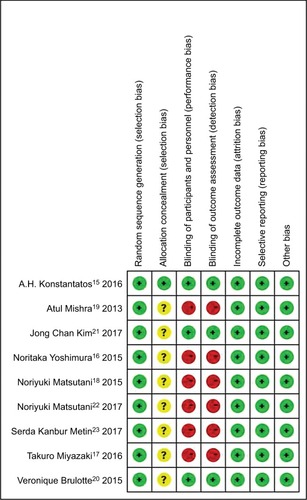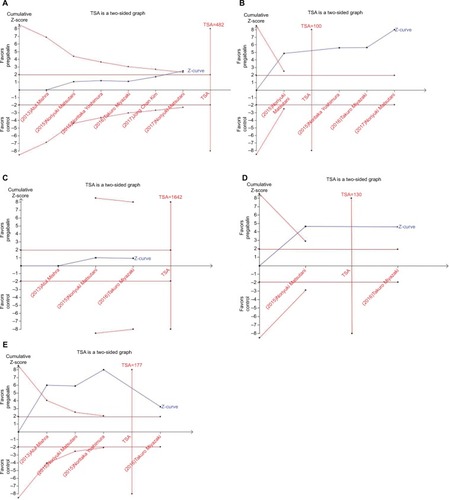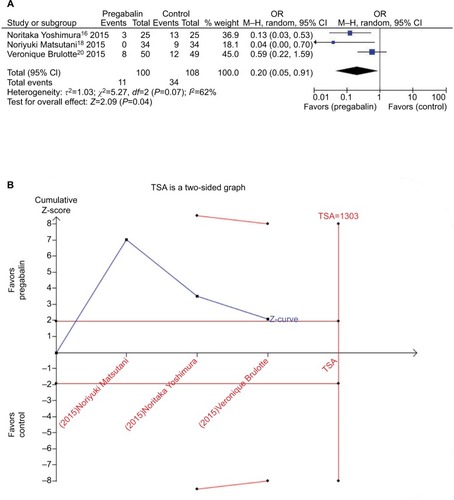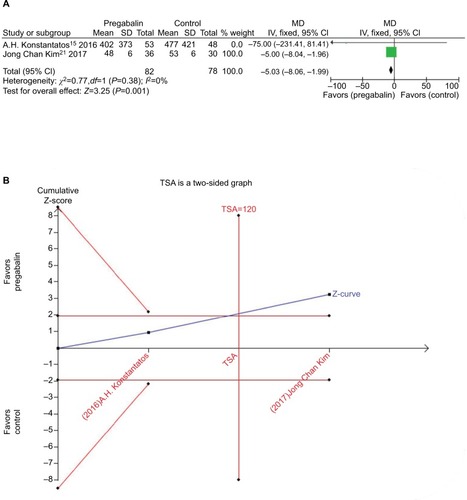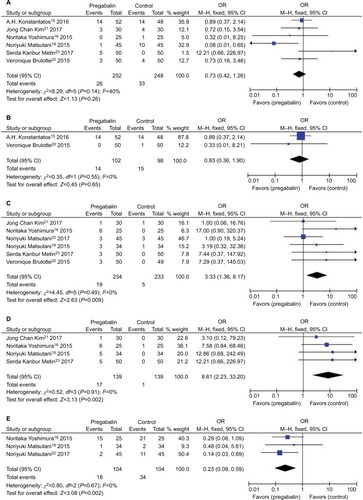Abstract
Purpose
Pregabalin is commonly used as an analgesic for neuropathic pain. But pregabalin as an adjunct to a multimodal analgesic regimen – although standard clinical protocol in some settings – has remained controversial. This meta-analysis was conducted to identify the efficacy of pregabalin for management of postoperative pain in thoracotomy.
Materials and methods
Pubmed, Embase, Cochrane, Web of Science, Springer, and Clinical Trial Register database were searched for randomized controlled trials (RCTs) of pregabalin in preventing postoperative pain in thoracotomy. Review Manager 5.3 and STATA 12.0 were selected to conduct the meta-analysis. Trial sequential analysis was used to control random errors and calculate the required information size.
Results
Nine RCTs with 684 patients were included in our meta-analysis. Outcomes favoring pregabalin included less pain on a 0–10 scale on 1 day [mean difference (MD): −0.87; 95% CI: −1.55 to −0.19; P=0.01], 3 days (MD: −1.55; 95% CI: −1.93 to −1.18; P<0.00001), 1 month (MD: −1.58; 95% CI: −2.75 to −0.42; P=0.008), 3 months (MD: −1.69; 95% CI: −2.71 to −0.66; P=0.001) postoperatively, and less incidence of neuropathic pain (OR: 0.20; 95% CI: 0.05–0.91; P=0.04), less mean morphine consumption (MD: −5.03; 95% CI: −8.06 to −1.99; P=0.001), but more dizziness (OR: 3.33; 95% CI: 1.36–8.17; P=0.009), more drowsiness (OR: 8.61; 95% CI: 2.23–33.20; P=0.002), and less constipation (OR: 0.23; 95% CI: 0.09–0.59; P=0.002). There was no statistical differences in pain score on 7 days (MD:–0.77; 95% CI: −2.38 to 0.84; P=0.35), nausea (OR: 0.73; 95% CI: 0.42–1.26; P=0.26), and vomiting (OR: 0.83; 95% CI: 0.36–1.90; P=0.65).
Conclusion
Pregabalin can prevent postoperative pain in thoracotomy and decrease incidence of neuropathic pain and morphine consumption. Pregabalin may be a valuable asset in management of acute and persistent postoperative pain in thoracotomy.
Introduction
Patients commonly experience acute to chronic pain after thoracotomy. Bayman et alCitation1 reported that a higher severity of pain at first postoperative 3 days may develop a higher rate of persistent pain. The incidence of chronic pain was 27% in thoracotomy and 8.2% were limited in their daily life. The incidence of chronic pain in video-assisted thoracoscopic surgery (VATS) was still not lower. Homma et alCitation2 reported that incidence of chronic neuropathic pain was 25.9% in VATS, and 18.8% even in a year later.
Thoracic epidural analgesia remained a controversy due to complications related to the catheterization procedure.Citation3 Opioid-based patient-controlled analgesia has been widely used for its analgesic efficacy but with several adverse effects including respiratory depression, sedation, vomiting, and physical dependence, and it may not be effective for chronic neuropathic pain.Citation4,Citation5
Pregabalin is a structural analog of γ-aminobutyric acid that acts on the α2δ subunit of voltage-dependent calcium channels, which can reduce the release of neurotransmitters.Citation6 It has been commonly used in treatment for neuropathic pain, but has remained a controversy in alleviating postoperative pain.Citation7 There was no systematic review with direct-evidence meta-analysis of randomized-controlled trials (RCTs) for pregabalin used in postoperative pain of thoracotomy. This meta-analysis was sought to determine whether pregabalin used systematically can reduce postoperative pain.
Material and methods
The protocol for the meta-analysis is registered with PROSPERO (CRD42018100634).
Search strategy
This systematic review of RCTs was performed in accordance with the criteria of the PRISMA statement and the current recommendations of the Cochrane Collaboration.Citation8,Citation9 We searched the PubMed, Embase, Cochrane, Web of Science, Springer, and Clinical trials register databases for related articles published on or before April 30, 2018, using the terms “ thoracotomy pain” or “ thoracoscopic pain” and “pregabalin”.
Study selection
Inclusion criteria
Settings and design: RCTs of pregabalin for prevention of postoperative pain in thoracotomy.
Study subjects: Patients who suffered postoperative pain in thoracotomy.
Interventions: The experimental group was administered pregabalin orally; the control group was administered conventional analgesia or placebo.
Outcome indicators: Postoperative pain scores and incidence of neuropathic pain.
Exclusion criteria
Combination with other antiepileptic drugs or anticon-vulsive drugs.
Incomplete data.
Trial selection, data extraction, and quality assessment
Two authors (Y-JY and NL) separately screened the articles, extracted data based on the inclusion and exclusion criteria, and evaluated the quality of each RCT using Cochrane Collaboration Risk of Bias Tool.Citation10 Disagreements were resolved by consensus. The opinion of a third author (J-RX) was obtained when agreement could not be reached.
The extracted data included first author’s name, publication data, type of surgery and anesthesia, patient demographic, sample size, details regarding pregabalin medication (dose and duration), morphine consumption, pain scores, postoperative complications, and side effects (nausea, vomiting, dizziness, drowsiness, and constipation).
RCTs were assessed for various types of bias, including selection, performance, detection, attrition, and reporting. RCT quality scores were not a factor for trial exclusion.
Definitions and outcomes
The main outcomes included the numerical rating scale or the visual analog scale (VAS) pain scores, the incidence of neuropathic pain, mean morphine consumption, and incidence of nausea, vomiting, dizziness, drowsiness, and constipation postoperatively.
If studies did not show complete data, we e-mailed authors requesting the original data. If there was no reply, we use the software of plot digitizer 2.6.8.0 to measure the exact numbers in figures. Pain scores were transformed to a standardized 0–10 analog scale (0= no pain and 10= worst pain imaginable).Citation11 Morphine consumption was the standard for opioid consumption. Fentanyl was converted to equi-analgesic morphine equivalent doses based on the following conversion scale: 100:1.Citation12
Statistical methods
The data were analyzed by Review Manager Software 5.3. The effect size for continuous data is expressed as the mean difference and the 95% CI. The effect size for dichotomous data is expressed as the OR and the 95% CI. The χ2-test P-value and the I2-value were used to determine the level of heterogeneity. A random effect model was used in cases of heterogeneity (P<0.1 or I2≥50%), and a fixed effect model was used in cases of homogeneity (P≥0.1 or I2<50%).Citation13 Publication bias using the Egger test and sensitivity analyses was conducted by STATA 12.0, where P>0.05 indicated no statistically significant publication bias.
Trial sequential analysis
Meta-analysis can result in type I errors (α) owing to repetitive testing of accumulated data, especially when the included studies have small sample sizes. Thus, we used trial sequential analysis (TSA) to examine the reliability and conclusiveness of our results. TSA depends on the quantification of the required information size. We calculated a diversity-adjusted (D2 required information size), since the heterogeneity adjustment with I2 underestimates the required information size and estimated the required information size using 0.05 for type 1 error and 0.20 for type 2 error. The relative risk reduction from the control group event rate from low-bias-risk trials included in the meta-analysis, according to the TSA user manual.Citation14 TSA software version 0.9.5.10 Beta (http://www.ctu.dk/tsa) was used in this study. If the cumulative Z-curve crossed the trial sequential monitoring boundary or exceeded the required information size, a significant result had been reached and no further studies were needed. Otherwise, further studies were necessary to confirm the results.
Results
Study selection and characteristics
The literature search included 9 qualifying RCTs with 684 patients that met inclusion criteria ().Citation15–Citation23 Quality assessment of RCTs was presented in and . The characteristics of patients and interventions are presented in . One was conducted in multicenters,Citation15 and others were conducted in a single center. All RCTs applied randomized strategies. Three studies applied double-blind strategies. Three hundred forty-four patients were in the pregabalin group and 340 were in the control group.Citation15,Citation20,Citation21 Two different dosages of pregabalin 150 mgCitation16–Citation19,Citation21,Citation22 or 300 mgCitation15,Citation20,Citation23 were administered to patients orally every day. The administration period was from 1 to 90 days. Postoperative analgesia included epidural analgesia, celecoxib, morphine, and nonsteroidal anti-inflammatory drugs. Postoperative analgesia details in control group can be seen in .
Table 1 Trial characteristics
Meta-analysis results
Postoperative pain scores
Six studies reported pain scores on postoperative 1 day. Pregabalin reduced scores by 0.87 points (n=385; 95% CI, −1.55 to −0.19, I2=63%, P=0.01). Four studies reported on postoperative 3 days. Pregabalin reduced scores by 1.55 points (n=275; 95% CI, −1.93 to −1.18, I2=0%, P<0.00001). Two studies reported on postoperative 1 month. Pregabalin reduced scores by 1.58 points (n=135; 95% CI, −2.75 to −0.42, I2=58%, P=0.008). Four studies reported on postoperative 3 months. Pregabalin reduced scores by 1.69 points (n=235; 95% CI, −2.71 to −0.66, I2=83%, P=0.001). There was no difference on postoperative 7 days (n=184; 95% CI: −2.38–0.84; I Citation2=92%; P=0.35; ).
Figure 4 Forest plot of meta-analysis: postoperative pain intensity in patients receiving pregabalin.
Abbreviations: IV, inverse variance; MD, mean difference.
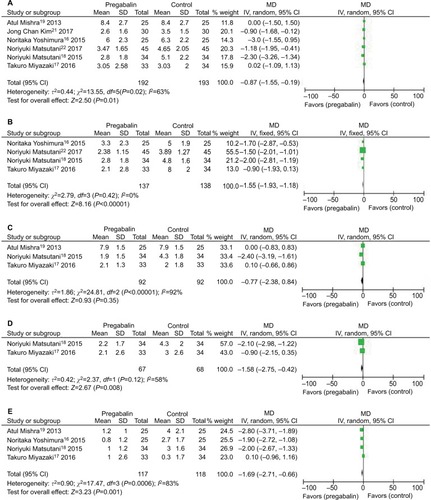
The Egger test for publication bias (P=0.601 on postoperative 1 day; P=0.778 on postoperative 3 days; P=0.761 on postoperative 7 days; and P=0.167 on postoperative 3 months); and sensitivity analysis did not significantly alter the summarized results. TSA results demonstrated that the cumulative Z-score of VAS on 1 day, 3 days, 1 month, and 3 months crossed its monitoring boundaries and reliable conclusions had been drawn. But the sample size of VAS on 7 days did not reach the required sample size ().
Incidence of neuropathic pain postoperatively
Three studies (n=217) investigated the incidence of postoperative neuropathic pain. The incidence of neuropathic pain was 80% lower with pregabalin (95% CI, 0.05–0.91, I2=62%, P=0.04). The Egger test for publication bias (P=0.296) and sensitivity analysis did not significantly alter the summarized results. And TSA indicated that the sample size in the meta-analysis did not reach the required sample size ().
Morphine consumption postoperatively
Results describing postoperative morphine consumption were available from two studies (n=160). Pregabalin was effective in reducing postoperative morphine consumption by −5.03 (95% CI: −8.06 to −1.99; I2=0%; P=0.001). Sensitivity analysis did not significantly alter the summarized results, and TSA indicated that crossed its monitoring boundaries and reliable conclusions had been drawn ().
Side effects
Six studies investigated the incidence of dizziness, and with pregabalin the incidence was higher (n=184; 95% CI: 1.36–8.17; I2=0%; P=0.009). The Egger test for publication bias (P=0.082). Four studies investigated the incidence of drowsiness, and with pregabalin the incidence was higher (n=278; 95% CI: 2.23–33.20; I2=0%; P=0.002). The Egger test for publication bias (P=0.826). Three studies investigated the incidence of constipation, and with pregabalin the incidence was lower (n=208; 95% CI: 0.09–0.59; I2=0%; P=0.002). The Egger test for publication bias (P=0.710). Six studies investigated the incidence of nausea and two studies investigated the incidence of vomiting. There was no statistically significant difference in nausea (n=500; 95% CI: 0.42–1.26; I2=40%; P=0.26; the Egger test for publication bias, P=0.867) and vomiting (n=200; 95% CI: 0.36–1.90; I2=0%; P=0.65; ). Sensitivity analysis did not significantly alter the summarized results. TSA indicated that the sample size in the meta-analysis did not reach the required sample size ().
Discussion
This is the first meta-analysis to evaluate the analgesic efficacy of pregabalin as an adjuvant to a perioperative multimodal analgesic regimen in thoracotomy. After analyzing the combined results of 9 RCTs, we found that pregabalin significantly reduced pain scores on 1 and 3 days and 1 and 3 months, reduced incidence of postoperative neuropathic pain, and reduced morphine consumption. However, the clinical significance of results may be limited by the heterogeneity in the included studies.
Our results are consistent with a meta-analysis that assess efficacy of pregabalin in acute postoperative pain under different surgical categories.Citation24 The results showed that pregabalin reduced the pain score at rest 2 hours after surgery in the cardiothoracic procedure. But there was not a definite conclusion for persistent pain because of insufficient data. In other articles of meta-analysis, the efficacy of pregabalin in the specific surgical style of thoracotomy was not mentioned. The efficacy of perioperative pregabalin treatment for preventing chronic pain remains a matter of debate. In a recent meta-analysis of pregabalin, it especially evaluates the incidence of chronic postsurgical pain (CPSP) in 3, 6, and 12 months and the incidence of chronic postsurgical neuropathic pain at the same time point, including all published and unpublished articles.Citation25 The conclusion is that the available data do not support with a moderate level of evidence for a systematic prevention of CPSP with pregabalin. Interestingly, it is shown that almost all of the overall effect comes from unpublished data being reverse of what one may expect and what has been published. None of unpublished trials reported pregabalin to be effective for preventing CPSP at any time (3, 6, and 12 months). In our study, pregabalin made a reduction in pain scores in 1 and 3 months and the incidence of postsurgical neuropathic pain, and it may be attributed to our study including all published articles under a single style surgery of thoracotomy. A higher incidence of chronic pain especially chronic neuropathic pain in the surgical style of thoracotomy, and pregabalin was used for chronic pain especially chronic neuropathic pain better than acute pain. It may be the reason why pregabalin is effective in thoracotomy.Citation1,Citation2 But the number of included articles was small. Therefore, more studies are needed to report the incidence of CPSP in thoracotomy, even when their results are not consistent with the earlier articles.
In addition, we found the morphine consumption was lower in the pregabalin group, although there were only two studies included. In a recent meta-analysis, it is shown that pregabalin may be a beneficial but small effect in postoperative pain management with minimal clinical relevant effect of morphine 5 mg in 24 hours of opioid consumption, this result was consistent with us.Citation26 We converted opioid use to morphine equivalents in studies because different opioid drugs and units were used to record opioid consumption. It was important to reduce opioid consumption because it has some side effects such as addiction, nausea, vomiting, constipation, and so on. In our study, there was a lower incidence of constipation, which may be the result of lower morphine consumption.Citation27
We also found that there was a higher incidence of dizziness and drowsiness. Dizziness and drowsiness were most common adverse effects of pregabalin. Griffin reported that dizziness, fatigue, and somnolence were among the most common adverse effects of pregabalin.Citation28 There was no significant difference of nausea and vomiting between the pregabalin group and the control group. In another study, postoperative administration of pregabalin has been shown to reduce nausea and vomiting for the reason of reduction in opioid consumption.Citation29,Citation30 In our study, the phenomenon that pregabalin did not reduce nausea and vomiting may result from the additional analgesic drugs with nonopioids instead of opioids drugs in most included studies.
This meta-analysis has several limitations that should be considered. First, the standard trials were limited, and the sample size was relatively insufficient, these factors could make the power test insufficient. Second, differences existed among trials, such as the doses of administration and outcome indicators of included RCTs. These factors may affect the meta-analysis and conclusion. Therefore, more high-quality studies are needed to reduce the effect of bias on study results.
Conclusion
In conclusion, our meta-analysis indicated that pregabalin could improve acute and chronic pain control, and reduce opioids consumption. However, future studies regarding doses and pregabalin medication are required.
Acknowledgments
This study was supported by The Medical Science Research Foundation of Zhejiang Province (2019314366), The Natural Science Fund of Zhejiang Province (LY17H090011) and The Science and Technology Department of Zhejiang Province Public Welfare Project (2016C33G2010165).
Disclosure
The authors report no conflicts of interest in this work.
References
- BaymanEOParekhKRKeechJSelteABrennanTJA prospective study of chronic pain after thoracic surgeryAnesthesiology2017126593895128248713
- HommaTDokiYYamamotoYRisk factors of neuropathic pain after thoracic surgeryJ Thorac Dis20181052898290729997955
- JoshiGPBonnetFShahRA systematic review of randomized trials evaluating regional techniques for postthoracotomy analgesiaAnesth Analg200810731026104018713924
- KehletHDahlJBThe value of “multimodal” or “balanced analgesia” in postoperative pain treatmentAnesth Analg1993775104810568105724
- YekkiralaASRobersonDPBeanBPBreaking barriers to novel analgesic drug developmentAnesthesiology20171611810
- LiZTaylorCPWeberMPregabalin is a potent and selective ligand for α(2)δ-1 and α(2)δ-2 calcium channel subunitsEur J Phar-macol20116671–38090
- GrayPPregabalin in the management of central neuropathic painExpert Opin Pharmacother20078173035304118001262
- HigginsJGreenSGuide to the contents of a Cochrane protocol and review. Cochrane Handbook for Systematic Reviews of Interventions version 5.1.0. Chapter 4The Cochrane Collaboration2011 Available from: http://www.cochrane-handbook.orgAccessed December 1, 2016
- LiberatiAAltmanDGTetzlaffJThe PRISMA statement for reporting systematic reviews and meta-analyses of studies that evaluate health-care interventions: explanation and elaborationBMJ20093397b270019622552
- EasterbrookPJBerlinJAGopalanRMatthewsDRPublication bias in clinical researchLancet199133787468678721672966
- BrogiEKazanRCyrSGiuntaFHemmerlingTMTransversus abdominal plane block for postoperative analgesia: a systematic review and meta-analysis of randomized-controlled trialsCan J Anaesth201663101184119627307177
- PereiraJLawlorPViganoADorganMBrueraEEquianalgesic dose ratios for opioids. a critical review and proposals for long-term dosingJ Pain Symptom Manage200122267268711495714
- HigginsJPThompsonSGQuantifying heterogeneity in a meta-analysisStat Med200221111539155812111919
- ThorlundKEngstrømJWetterslevJBrokJImbergerGGluudCUser Manual for Trial Sequential Analysis (TSA)Copenhagen, Den-markCopenhagen Trial Unit, Centre for Clinical Intervention Research20111115
- KonstantatosAHHowardWStoryDMokLYBoydDChanMTA randomised controlled trial of peri-operative pregabalin vs. placebo for video-assisted thoracoscopic surgeryAnaesthesia201671219219726566754
- YoshimuraNIidaHTakenakaMEffect of postoperative administration of pregabalin for post-thoracotomy pain: a randomized studyJ Cardiothorac Vasc Anesth20152961567157226341878
- MiyazakiTSakaiTSatoSIs early postoperative administration of pregabalin beneficial for patients with lung cancer? Randomized control trialJ Thorac Dis20168123572357928149551
- MatsutaniNDejimaHTakahashiYKawamuraMPregabalin reduces post-surgical pain after thoracotomy: a prospective, randomized, controlled trialSurg Today201545111411141625430812
- MishraANarASBawaAKaurGBawaSMishraSPregabalin in chronic post-thoracotomy painJ Clin Diagn Res2013781659166124086867
- BrulotteVRuelMMLafontaineEChouinardPGirardFImpact of pregabalin on the occurrence of postthoracotomy pain syndrome: a randomized trialReg Anesth Pain Med201540326226925899956
- KimJCByunSKimSEffect of preoperative pregabalin as an adjunct to a multimodal analgesic regimen in video-assisted thoracoscopic surgery: a randomized controlled trialMedicine20179649e864429245223
- MatsutaniNDejimaHNakayamaTImpact of pregabalin on early phase post-thoracotomy pain compared with epidural analgesiaJ Thorac Dis20179103766377329268384
- MetinSKMeydanBEvmanSDogruyolTBaysungurVThe effect of pregabalin and methylcobalamin combination on the chronic postthoracotomy pain syndromeAnn Thorac Surg201710341109111327916242
- LamDMChoiSWWongSSIrwinMGCheungCWEfficacy of pre-gabalin in acute postoperative pain under different surgical categories: a meta-analysisMedicine20159446e194426579802
- MartinezVPichardXFletcherDPerioperative pregabalin administration does not prevent chronic postoperative pain: systematic review with a meta-analysis of randomized trialsPain2017158577578328296652
- FabritiusMLStrømCKoyuncuSBenefit and harm of pregabalin in acute pain treatment: a systematic review with meta-analyses and trial sequential analysesBr J Anaesth2017119477579129121288
- NalamachuSGudinJDattoCEfficacy and safety of naloxegol for opioid-induced constipation assessed by specific opioid medication, opioid dose, and duration of opioid useJ Opioid Manag201814321122130044486
- GriffinEBrownJNPregabalin for the treatment of restless legs syndromeAnn Pharmacother201650758659127091870
- LiFMaJKuangMThe efficacy of pregabalin for the management of postoperative pain in primary total knee and hip arthroplasty: a meta-analysisJ Orthop Surg Res20171214928340617
- SawanHChenAFViscusiERParviziJHozackWJPregabalin reduces opioid consumption and improves outcome in chronic pain patients undergoing total knee arthroplastyPhys Sportsmed20144221018

